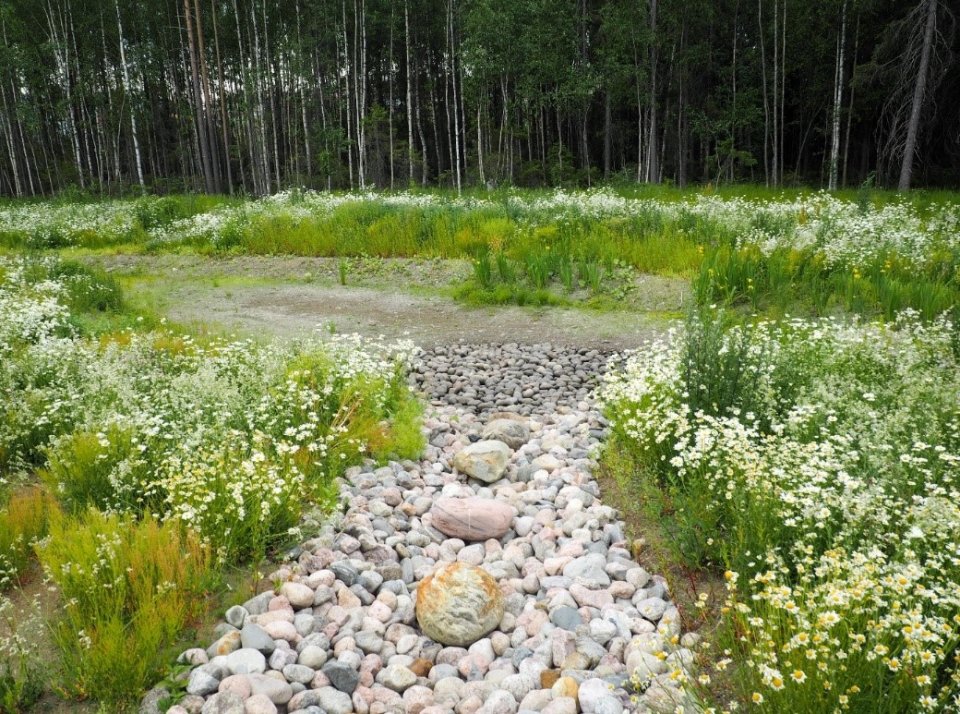
Retention pond’s water area varies from ca. 150 m2 to ca. 690 m2 depending on the water level. It receives stormwater from a newly built housing estate through a stormwater pipeline. The pond has been formed on a formerly marshy area, that has been partially filled with crushed rock, by building an embankment out of moraine. Water exits the pond by infiltration and filtration through the moraine embankment. There is a stone covered overflow route over the embankment for heavy storm events. The normal water elevation in the pond is +121.3 and maximum flood elevation is +121.8. The normal water level is maintained through high ground water levels in the remaining marshy area. The retention pond is surrounded by alluvial meadows, which are covered by water during rain events.
Treatment (retention and sedimentation) of urban runoff from new housing around Tervaslampi park to complement the measures for enhanced stormwater quality and quantity management in the Vuores area. Vegetation is selected from the local species to support biodiversity. Additionally, the area is equipped with the information sign introducing the NbS and its functions.
Flooding indicators included those related to surface runoff, time to flood peak and flood peak height (or, water depth), and they were evaluated with the help of modelling. Retention pond and alluvial meadows in Vuores demonstrated 94% and 88% reduction in surface runoff and a 86% and 90% reduction in water depth for a 10- and 100-year return periods respectively when compared to no NbS situation. The retention pond and alluvial meadows NbS had a very notable effect in decreasing the runoff coefficient, performing better than the biofilter even during high intensity precipitation events. The effect will not be so prominent if the pond is partly filled before the storm event. The retention pond and alluvial meadows scenario had the opposite effect on delaying the flood peak time, accelerating flood peak occurrence (-35% and -9% for 10- and 100-year return periods), however discharge values were greatly diminished.
In the survey regarding the Vuores stormwater management system, the respondents rated highly such aspects as easiness of reach, aesthetics and feeling of connectedness with nature. Aspects related to increased physical activity, extending time spent outdoors or making a longer route received score from 3.6 to 4. In total 93% of Vuores residents perceived the stormwater management system as improving their living conditions.
- Flood peak reduction
- Increase infiltration / Water storage
- Reduce flood risk
- Reduce load to sewer system
- Reduce run-off
- Improve connectivity and functionality of green and blue infrastructures
- Increase Biodiversity
- Increase quality and quantity of green and blue infrastructures
- Increase amount of green open spaces for residents
- Increase awareness of NBS solution & their effectiveness and co benefits
Retention ponds can be implemented in urban areas for the improvement of water quality and prevention of floods. When complemented with a sand filter, the ponds can effectively treat runoff from construction sites - a typical solution used in construction sites in Tampere. However, in some cases the ponds have been too small as retention ponds need enough space for effective sedimentation. In Tampere, retention ponds are being replicated to new residential areas, but are designed to have a lower permanent water level.
The decentralised, hybrid (grey, blue and green infrastructure) stormwater management system of Vuores performs well for retention and purification of urban runoff. However, interpretation of monitoring data was challenging at times due to the complexity of the system. The acceptance of “new urban aesthetics” such as meadows and bushes instead of neat grass was challenged by the citizens' understanding of the system function and need.
- Retention pond
